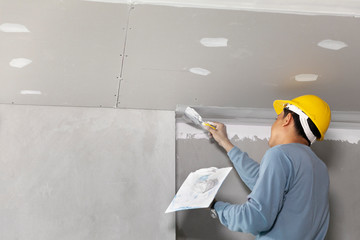Drywall is one of the most inexpensive and DIY-friendly building materials. It’s also easy to install and requires only a handful of hand tools. Before hanging drywall, make sure the framing of the ceiling and walls is level from stud to stud. Uneven framing can bow the panels and add strange contours or cracks to the walls.

Drywall installation may be performed by professional contractors or experienced Handyman Naperville IL. It requires specialized tools and equipment and a good understanding of the building codes and regulations governing drywall installation. Drywall installation is one of the most affordable and easiest ways to get new walls in your home. However, it is also a project that requires attention to detail.
The first step is to measure the space that needs to be drywalled. This will help you avoid extra waste from cutting and measuring later. Next, cut a sheet of drywall to a width that will accommodate the length of the walls. This will help you avoid wasting material and ensure the wall is tight against the ceiling.
If the room will need electrical outlets or light switches, it is important to reroute these before hanging the drywall. This will make the new drywall installation go smoothly and prevent any damage to electrical and plumbing lines.
After installing the drywall, it’s time to tape and mud it. This is the most tedious part of a drywall installation, but it can also be done faster and easier if you use proper techniques.
Drywall is a versatile building material used to create walls and ceilings. Learning how to hang drywall is an important skill for any DIYer.
Once you know how to hang drywall, you can easily transform your home or commercial building. It’s also a great way to save money on small renovations and upgrades.
When hanging drywall, it’s critical to ensure the sheets are level and flush against each other. This will reduce the amount of joint compound needed to fill in gaps between the sheets.
To begin, measure and mark the first sheet to fit vertically against the studs in the top corner. Then tap a few ring drywall nails through the panel into the studs to secure it.
Continue working around the room, accounting for windows, doors, and any electrical boxes. Remember to leave a few inches of space between each sheet to account for any corners that need to be cut out.
The finishing phase of a Drywall installation is an important step in making the wall surface smooth and ready for painting. The process consists of taping over the joints between the panels, applying joint compound and sanding to get a smooth surface.
To make the drywall installation process easier and faster, take some time to familiarize yourself with the basics of Drywall Finishing. This will help you communicate better with your architects or specifiers and ensure they understand what you need from them on the job.
The six levels of drywall finishing, defined by the industry, are designed to help to build owners, specifiers, and contractors more easily define what they’re looking for on the job. Whether dealing with an interior or exterior wall surface, these levels provide a standard for achieving the look and feel you’re after.
The best part about a drywall job is the cleanup. A quick wipe-down with a microfiber cloth is all it takes to reveal a fresh canvas for the rest of the night’s sleep. For the most part, this task is best left to the professionals. You can count on a hefty bill for this task, but the rewards will be well worth it! As mentioned earlier, eponymous’s toes will be thanking you for years to come.
Drywall installation refers to installing drywall, or gypsum board or plasterboard, on interior walls and ceilings. Drywall is a common construction material used to create a smooth, flat surface that can be painted, wallpapered, or textured.
The drywall installation typically involves measuring and cutting the drywall sheets to fit the dimensions of the wall or ceiling and then securing the drywall to the framing using screws or nails. The seams between the drywall sheets are then covered with joint tape and joint compound to create a seamless, smooth surface.
Once the joint compound has dried, the surface is sanded to create a smooth, flat finish. The drywall can then be painted, wallpapered, or textured as desired.
Overall, drywall installation is an important part of the construction process, as it provides a durable, smooth surface for interior walls and ceilings that can be easily finished to create the desired look and feel.
